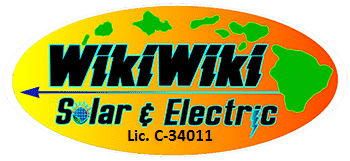What Affects the Efficiency of Solar Panels in Maui?
Solar panels typically convert 15-22% of solar energy into electrical power, depending on various factors such as:
- Weather conditions
- Placement, orientation, inclination, and wiring
- Type of solar panels Maui used, such as thin-film, mono-crystalline, or poly-crystalline
- Shaded areas, temperature, and sunlight hours
- Quality of the inverter that converts AC to DC.
The efficiency of solar panels Maui is measured at Standard Test Conditions (STC) under a specific irradiance of 1,000 W/m2 and temperature of 25°C. Under these conditions, a panel with a surface area of 1 m2 and 15% efficiency is expected to produce 150 Watts of electricity. However, lab conditions can differ from real-life situations.
Let’s take a look at how different types of panels provide various outputs:
- Monocrystalline Solar Panels: These are also known as single-crystalline cells. They are dark in color and have rounded edges. They are highly efficient compared to other types of solar panels, with efficiency ranging from 22-27% under STC.
- Polycrystalline Solar Panels: These are often referred to as multi-crystalline cells, and their efficiency under Standard Test Conditions ranges from 15-22%. They have a blue speckled color and square shape.
- Thin Film Solar Panels: This type of solar panel is lightweight and flexible and covered with a substrate of glass, plastic, or metal. The efficiency may range between 15-22%.
Factors Affecting the Efficiency of Panels:
When installing solar panels maui, the latitude of the location, orientation, inclination, irradiation, and climatic conditions play a crucial role in determining energy efficiency. Let’s discuss these factors in detail:
1. Weather and Climatic Conditions
Many people assume that temperature is directly proportional to energy production, which is not true. Rather, high temperatures result in a drop in voltage and energy production. On a hot summer day, when the temperature rises to 70˚C or more, there is a 25% reduction in power production compared to when the temperature is 25˚C.
2. Shading
Shading is inversely proportional to the power production efficiency of solar panels maui. Sunlight should directly fall on the panels to activate the cells, and if parts of the solar panels are in the shade, it will affect the flow of the electrical current and decrease electricity production drastically.
3. Orientation of the Roof
In the Northern Hemisphere, solar panels should face the south direction since the sun is always in the southern part of the sky. They should be tilted up to a 30-40 degree angle to capture sunlight more efficiently.
4. Cleanliness
The surface of solar panels must be cleaned frequently to remove dust and dirt, or they won’t be able to provide the best output.
5. Location and Climatic Conditions
The availability of sunlight is the first factor to consider when selecting a location. If sunshine is scarce, solar panels won’t be able to produce the expected results. Heavy fog, snow, or acute temperature conditions may also affect the performance of solar panels.
Final Words: If you’re eager to install the best solar panels Maui, it’s essential to understand that the energy efficiency of panels may vary under different conditions. However, it’s necessary to install them correctly. Wiki Wiki Solar & Electric can help you choose the best panels and install them correctly. Contact our Maui solar experts now!
